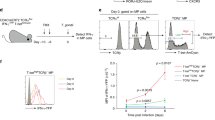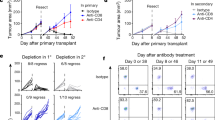Abstract
In vivo models have shown that tissue-restricted antigen may be captured by bone marrow–derived cells and cross-presented for the tolerization of CD8+ T cells. Although these studies have shown peripheral tolerization of CD8+ T cells, the mechanism of antigen transfer and the nature of the antigen-presenting cell (APC) remain undefined. We report here the establishment of an in vitro system for the study of cross-tolerance and show that dendritic cells (DCs) phagocytose apoptotic cells and tolerize antigen-specific CD8+ T cells when cognate CD4+ T helper cells are absent. Using this system, we directly tested the “two-signal” hypothesis for the regulation of priming versus tolerance. We found that the same CD83+ myeloid-derived DCs were required for both cross-priming and cross-tolerance. These data suggested that the current model for peripheral T cell tolerance, “signal 1 in the absence of signal 2”, requires refinement: the critical checkpoint is not DC maturation, but instead the presence of a third signal, which is active at the DC–CD4+ T cell interface.
This is a preview of subscription content, access via your institution
Access options
Subscribe to this journal
Receive 12 print issues and online access
$209.00 per year
only $17.42 per issue
Buy this article
- Purchase on Springer Link
- Instant access to full article PDF
Prices may be subject to local taxes which are calculated during checkout





Similar content being viewed by others
References
Miller, J. F. & Morahan, G. Peripheral T cell tolerance. Annu. Rev. Immunol. 10, 51–69 (1992).
Kurts, C., Kosaka, H., Carbone, F. R., Miller, J. F. & Heath, W. R. Class I-restricted cross-presentation of exogenous self-antigens leads to deletion of autoreactive CD8+ T cells. J. Exp. Med. 186, 239–245 (1997).
Adler, A. J. et al. CD4+ T cell tolerance to parenchymal self-antigens requires presentation by bone marrow-derived antigen-presenting cells. J. Exp. Med. 187, 1555–1564 (1998).
Kurts C, et al. Constitutive class I-restricted exogenous presentation of self antigens in vivo. J. Exp. Med. 184, 923–930 (1996).
Kurts, C., Heath, W. R., Kosaka, H., Miller, J. F. & Carbone, F. R. The peripheral deletion of autoreactive CD8+ T cells induced by cross- presentation of self-antigens involves signaling though CD95 (Fas, Apo- 1). J. Exp. Med. 188, 415–420 (1998).
Kurts, C. et al. Constitutive class I-restricted exogenous presentation of self antigens in vivo. J. Exp. Med. 184, 923–930 (1996).
Heath, W. R., Kurts, C., Miller, J. F. & Carbone, F. R. Cross-tolerance: a pathway for inducing tolerance to peripheral tissue antigens. J. Exp. Med. 187, 1549–1553 (1998).
Steinman, R. M., Turley, S., Mellman, I. & Inaba, K. The induction of tolerance by dendritic cells that have captured apoptotic cells. J. Exp. Med. 191, 411–416 (2000).
Green, D. R. & Beere, H. M. Apoptosis. Gone but not forgotten. Nature 405, 28–29 (2000).
Mellman, I. & Steinman, R. M. Dendritic cells: specialized and regulated antigen processing machines. Cell 106, 255–258 (2001).
Albert, M. L., Sauter, B. & Bhardwaj, N. Dendritic cells acquire antigen from apoptotic cells and induce class I- restricted CTLs. Nature 392, 86–89 (1998).
Albert, M. L. et al. Tumor-specific killer cells in paraneoplastic cerebellar degeneration. Nature Med. 4, 1321–1324 (1998).
Albert, M. L. et al. Immature dendritic cells phagocytose apoptotic cells via αvβ5 and CD36, and cross-present antigens to cytotoxic T lymphocytes. J. Exp. Med. 188, 1359–1368 (1998).
Lu, Z. et al. CD40-independent pathways of T cell help for priming of CD8+ cytotoxic T lymphocytes. J. Exp. Med. 191, 541–550 (2000).
Bennett, S. R. et al. Help for cytotoxic-T-cell responses is mediated by CD40 signalling Nature 393, 478–480 (1998).
Schoenberger, S. P., Toes, R. E., van der Voort, E. I., Offringa, R. & Melief, C. J. T-cell help for cytotoxic T lymphocytes is mediated by CD40-CD40L interactions. Nature 393, 480–483 (1998).
Ridge, J. P., Di Rosa, F. & Matzinger, P. A conditioned dendritic cell can be a temporal bridge between a CD4+ T- helper and a T-killer cell. Nature 393, 474–478 (1998).
Kurts, C. et al. CD4+ T cell help impairs CD8+ T cell deletion induced by cross- presentation of self-antigens and favors autoimmunity. J. Exp. Med. 186, 2057–2062 (1997).
Gallucci, S., Lolkema, M. & Matzinger, P. Natural adjuvants: endogenous activators of dendritic cells Nature Med. 5, 1249–1255 (1999).
Garza, K. M. et al. Role of antigen-presenting cells in mediating tolerance and autoimmunity. J. Exp. Med. 191, 2021–2027 (2000).
Banchereau, J. & Steinman, R. M. Dendritic cells and the control of immunity. Nature 392, 245–252 (1998).
Guerder, S. & Flavell, R. A. Costimulation in tolerance and autoimmunity. Int. Rev. Immunol. 13, 135–146 (1995).
Johnson, J. G. & Jenkins, M. K. Accessory cell-derived signals required for T cell activation. Immunol. Res. 12, 48–64 (1993).
Austyn, J. M. Death, destruction, danger and dendritic cells. Nature Med. 5, 1232–1233 (1999).
Huang, F. P. et al. A discrete subpopulation of dendritic cells transports apoptotic intestinal epithelial cells to T cell areas of mesenteric lymph nodes. J. Exp. Med. 191, 435–444 (2000).
Bevan, M. J. Cross-priming for a secondary cytotoxic response to minor H antigens with H-2 congenic cells which do not cross-react in the cytotoxic assay. J. Exp. Med. 143, 1283–1288 (1976).
Kurts, C., Cannarile, M., Klebba, I. & Brocker, T. Dendritic cells are sufficient to cross-present self-antigens to CD8 T cells in vivo. J Immunol 166, 1439–1442 (2001).
Grohmann, U. et al. CD40 ligation ablates the tolerogenic potential of lymphoid dendritic cells. J. Immunol. 166, 277–283 (2001).
Diehl, L. et al. CD40 activation in vivo overcomes peptide-induced peripheral cytotoxic T-lymphocyte tolerance and augments anti-tumor vaccine efficacy. Nature Med. 5, 774–779 (1999).
Cyster, J. G. Leukocyte migration: scent of the T zone. Curr. Biol. 10, 30–33 (2000).
Forster, R. et al. CCR7 coordinates the primary immune response by establishing functional microenvironments in secondary lymphoid organs. Cell 99, 23–33 (1999).
Dhodapkar, M. V., Steinman, R. M., Krasovsky, J., Munz, C. & Bhardwaj, N. Antigen-specific inhibition of effector T cell function in humans after injection of immature dendritic cells. J. Exp. Med. 193, 233–238 (2001).
Randolph, G. J., Beaulieu, S., Lebecque, S., Steinman, R. M. & Muller, W. A. Differentiation of monocytes into dendritic cells in a model of transendothelial trafficking. Science 282, 480–483 (1998).
Caux, C. et al. Activation of human dendritic cells though CD40 cross-linking. J. Exp. Med. 180, 1263–1272 (1994).
Wong, B. R. et al. TRANCE (tumor necrosis factor [TNF]-related activation-induced cytokine), a new TNF family member predominantly expressed in T cells, is a dendritic cell-specific survival factor. J. Exp. Med. 186, 2075–2080 (1997).
Khanna, R. et al. Engagement of CD40 antigen with soluble CD40 ligand up-regulates peptide transporter expression and restores endogenous processing function in Burkitt's lymphoma cells. J. Immunol. 159, 5782–5785 (1997).
Rieser, C., Bock, G., Klocker, H., Bartsch, G. & Thurnher, M. Prostaglandin E2 and tumor necrosis factor α cooperate to activate human dendritic cells: synergistic activation of interleukin 12 production. J. Exp. Med. 186, 1603–1608 (1997).
Gotch, F., Rothbard, J., Howland, K., Townsend, A. & McMichael, A. Cytotoxic T lymphocytes recognize a fragment of influenza virus matrix protein in association with HLA-A2. Nature 326, 881–882 (1987).
Acknowledgements
We thank N. Blachère, N. Bhardwaj and S. Amigorena for helpful discussions and critical review of the manuscript. Supported by the NIH-NCI and the NCC (M. L. A.), The Susan G. Komen Breast Cancer Foundation (R. B. D.) and the Burroughs-Wellcome Fund (R. B. D.).
Author information
Authors and Affiliations
Corresponding author
Supplementary information
Web Figure 1.
Mature DCs exposed to CD40L do not further up-regulate DC maturation markers. To evaluate the phenotype of macrophages and DCs at different stages of differentiation, cells were surface labeled with lineage markers (CD14 and CD83) as well as with markers that correlate with the state of DC maturation (HLA-DR and CD86). Additionally we analyzed cells for candidate molecules that may distinguish the phenotype of "tolerizing" versus "activating" DCs (CD40, RANK and OX40). While we confirmed the previously reported phenotypic differences between macrophages, immature DCs and mature DCs, we did not identify phenotypic differences between the mature DCs +/- CD40L treatment. (GIF 38 kb)
Web Figure 2.
Mature DCs +/- CD40L express similar amounts of MHC class I. To evaluate surface MHC class I expression at different stages of DC differentiation, cells were surface labeled with anti-HLA-A,B,C. While we confirmed the previously reported two-fold increase in MHC class I expression during DC maturation, we did not identify up-regulation of MHC class I upon CD40L treatment. Immature DCs were prepared from peripheral blood monocytes using GM-CSF and IL-4 as described. Treatment of immature DCs with TNF-α and PGE-2 for 36 h. resulted in the generation of mature DCs. An additional 40-h incubation with CD40L yielded the CD40L-mature DC cultures. Cells treated with IgG control antibody were used to establish FACS settings (black lines). (GIF 14 kb)
Web Figure 3.
Schematic representation of two models for distinguishing antigen cross-priming from cross-tolerance. We propose two models for how DCs might trigger the distinct immunological outcomes of antigen cross-presentation. (GIF 20 kb)
Rights and permissions
About this article
Cite this article
Albert, M., Jegathesan, M. & Darnell, R. Dendritic cell maturation is required for the cross-tolerization of CD8+ T cells. Nat Immunol 2, 1010–1017 (2001). https://doi.org/10.1038/ni722
Received:
Accepted:
Published:
Issue Date:
DOI: https://doi.org/10.1038/ni722
This article is cited by
-
Regulation of immunological tolerance by the p53-inhibitor iASPP
Cell Death & Disease (2023)
-
T-cell responses and combined immunotherapy against human carbonic anhydrase 9-expressing mouse renal cell carcinoma
Cancer Immunology, Immunotherapy (2022)
-
G2-S16 dendrimer microbicide does not interfere with the vaginal immune system
Journal of Nanobiotechnology (2019)
-
Promoting the accumulation of tumor-specific T cells in tumor tissues by dendritic cell vaccines and chemokine-modulating agents
Nature Protocols (2018)
-
Dying cells actively regulate adaptive immune responses
Nature Reviews Immunology (2017)



